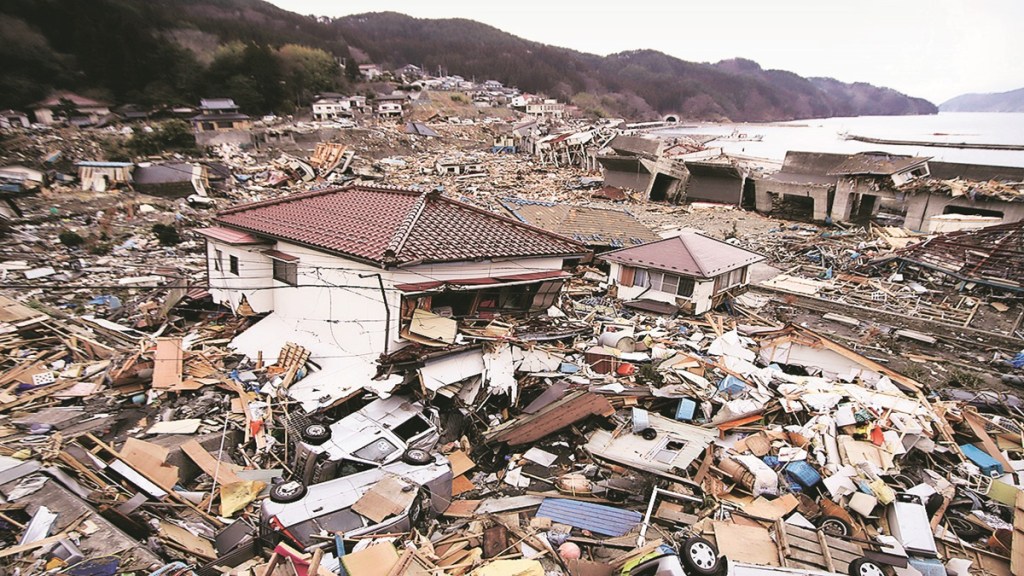On March 31, the Japanese government came out with a forecast report that Japan is on a high alert for megaquakes for the next 30 years, raising significant concerns about the economy and about life on the island country itself.
The country stands to suffer losses of up to $1.81 trillion (which is almost half of the country’s gross domestic product), potentially lose an estimated 2,98,000 lives, and displace as many as 1.2 million people (which is close to 1% of its population). Of the forecast fatalities, the report estimates that approximately 2,15,000 lives will be lost to the tsunami triggered by the quake, as many as 73,000 people could die from buildings collapsing, and fires could cause 9,000 deaths. Previously, Japanese authorities had estimated that the megaquake could cause damages worth $1.4 trillion.
A megaquake is an earthquake that has a magnitude of 8 or higher. The last megaquake that took place on the Nankai Trough in Japan was in 1946, along the edge of Shikoku. It was a magnitude 8 disaster that led to the loss of over 1,300 lives. In 1940, another major earthquake of 7.5 magnitude had struck off the coast of Hokkaido and induced a tsunami. At least 10 people died in it and 24 were injured. More recently, in 2011, Japan had also witnessed a magnitude 9 quake that triggered a tsunami, and resulted in triple reactor meltdowns at a nuclear power plant in the northeast region of the country. The triple tragedy led to the loss of at least 15,000 lives. The most powerful megaquake ever recorded, though, was in Chile in May of 1960. A 9.5 magnitude quake occurred along a fault nearly 1,600 km long and caused as many as 1,655 deaths in Chile. Over 3,000 people were injured, 2 million were displaced, and economic damage worth $550 million was noted. At the same time, the quake had also triggered a tsunami in the Pacific Ocean that led to 61 deaths in Hawaii, 138 deaths in Japan, and over 30 dead (or missing) in the Philippines.
Incidentally, megaquakes are said to occur once every 100-150 years, due to accumulating tectonic strain. Reports explain that as the tectonic plates move, they become stuck and store massive amounts of energy. When they try to break free, the energy is released and causes huge earthquakes.
Seismic activity
Japanese authorities have said that there’s an 80% chance of a 9 magnitude megaquake causing destruction along south Japan’s 900-km-long Nankai Trough on the Pacific coast within the next 30 years. The Trough is located where the Philippine Sea Plate is subducting under the Eurasian Plate. Why this could be so devastating is that a megaquake can trigger multiple and massive tsunamis which could lead to the collapse of the country’s infrastructure. Even a rupture on this coastline, say experts, could trigger tsunamis as high as 30-34 metres within minutes. Places in Japan like Shizuoka, Kochi, and Wakayama would be the most vulnerable. But a rupture or a tsunami would not be the last of the problems in this geography. Experts at Tohoku and Kyoto Universities, as quoted in media reports, have warned that a megaquake on the Nankai Trough could also result in a follow-up tremor being 100-3,600 times more likely within a week of the shock.
Pacific ring of fire
Japan is, anyway, geographically located in one of the world’s most seismically active zones — also known as the Pacific ring of fire. Situated over four tectonic plates that constantly move and hit each other, the country is said to approximately face over 1,500 earthquakes annually. Fortunately, most of them are minor and do not cause significant damage.
However, the country does record seismic activity every five minutes or so, on average. An International Institute of Seismology and Earthquake Engineering seismologist had told the media previously that 18% of all the earthquakes globally occur in Japan (and its nearby countries). Since Japan is prepared in dealing with earthquakes, the country’s Meteorological Agency had issued its first-ever megaquake advisory last year, forecasting a magnitude 9 quake after it was hit by a magnitude 7.1 earthquake at the edge of the Nankai Trough.
The country’s fire and disaster management agency instructed at least 707 municipalities (which were considered at risk from the possible Nankai Trough megaquake) to review their response strategies, evacuation plans, and essentially be prepared. The authorities also asked the public not to panic, and instead prepare themselves by stocking up on emergency goods, having an evacuation plan in place for their families, and staying calm.
